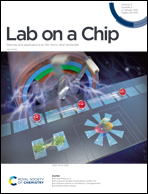Real-time isothermal DNA amplification monitoring in picoliter volumes using an optical fiber sensor†
Abstract
Rolling circle amplification (RCA) of DNA can be considered as a great alternative to the gold standard polymerase chain reaction (PCR), especially during this pandemic period, where rapid, sensitive, and reliable test results for hundreds of thousands of samples are required daily. This work presents the first research to date on direct, real-time and label-free isothermal DNA amplification monitoring using a microcavity in-line Mach–Zehnder interferometer (μIMZI) fabricated in an optical fiber. The solution based on μIMZI offers a great advantage over many other sensing concepts – making possible optical analysis in just picoliter sample volumes. The selectivity of the biosensor is determined by DNA primers immobilized on the microcavity's surface that act as selective biorecognition elements and trigger initiation of the DNA amplification process. In this study, we verified the sensing concept using circular DNA designed to target the H5N1 influenza virus. The developed biosensor exhibits an ultrahigh refractive index sensitivity reaching 14 000 nm per refractive index unit and a linear detection range between 9.4 aM and 94 pM of the target DNA sequence. Within a 30 min period, the amplification of as little as 9.4 aM DNA can be effectively detected, with a calculated limit of detection of as low as 0.2 aM DNA, suggesting that this methodology holds great promise in practical disease diagnosis applications in the future.



 Please wait while we load your content...
Please wait while we load your content...